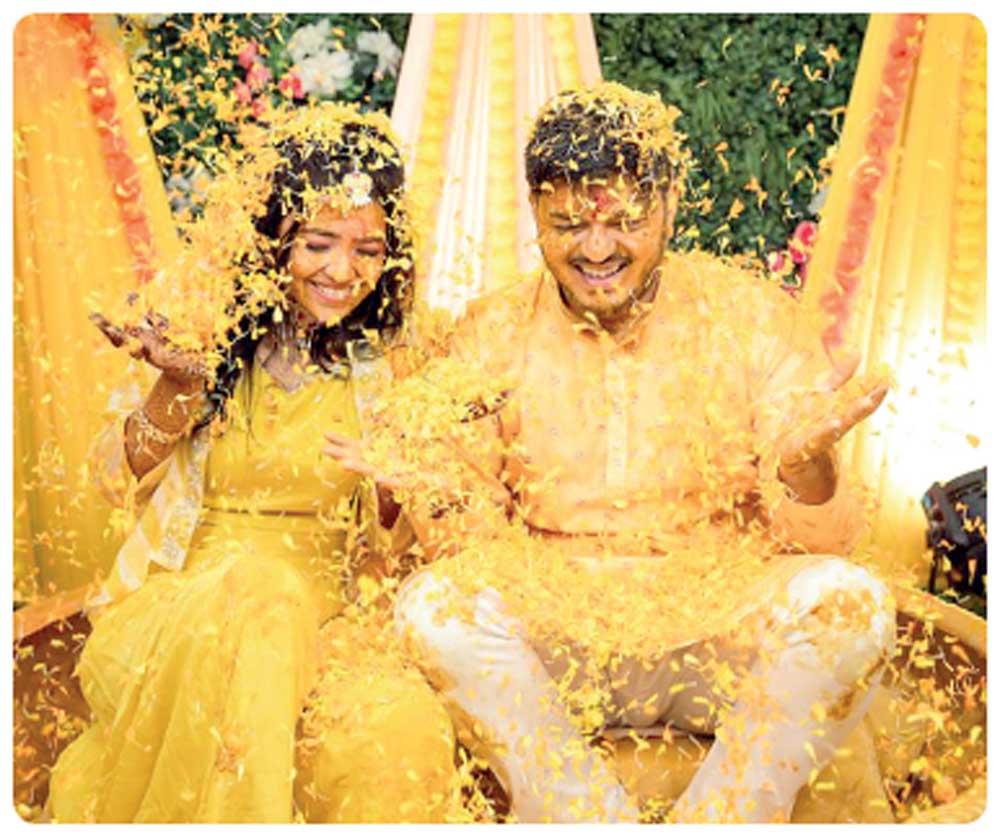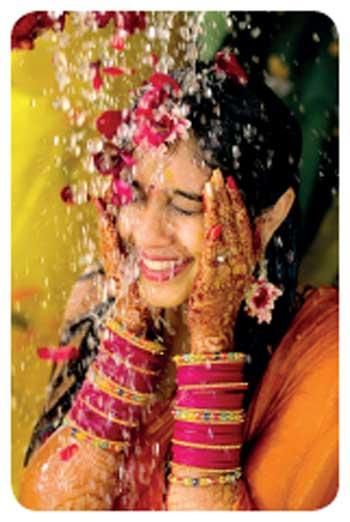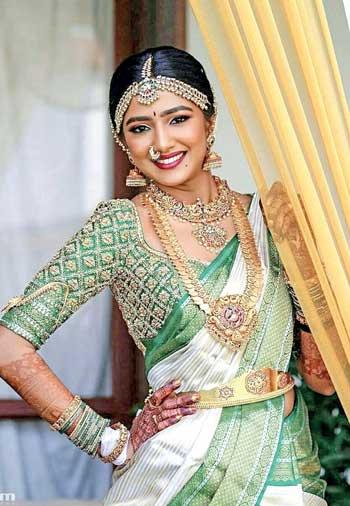
- In modern times many Tamil brides have started experimenting with pastel tones or even shades like peach and lavender
 Weddings are often a reflection of cultural traditions passed down for generations and in Tamil Hindu culture every ritual every flower and every thread carries meaning. One of the most visually stunning aspects of a Tamil wedding is the bride’s saree. While the world may admire the elegance and grace of a traditionally dressed Tamil bride few pause to consider why certain colors are chosen for this important moment. In reality the color of the bridal saree is not a fashion choice alone, but a symbol rooted deeply in spirituality beliefs and centuries of cultural knowledge.
Weddings are often a reflection of cultural traditions passed down for generations and in Tamil Hindu culture every ritual every flower and every thread carries meaning. One of the most visually stunning aspects of a Tamil wedding is the bride’s saree. While the world may admire the elegance and grace of a traditionally dressed Tamil bride few pause to consider why certain colors are chosen for this important moment. In reality the color of the bridal saree is not a fashion choice alone, but a symbol rooted deeply in spirituality beliefs and centuries of cultural knowledge.
Interestingly some brides wear more than one saree during the course of the wedding. It is not uncommon for a Tamil bride to have different sarees for each part of the ceremony
01. Tamil Hindu brides typically wear sarees in shades of red, yellow, green or even combinations of these during the various wedding ceremonies. Each of these colors has a purpose and is selected based on the kind of energy and blessing it is believed to bring into the bride’s married life. Red for instance is perhaps the most popular bridal color in Tamil weddings. To the untrained eye red may simply seem like a bright or bold choice but within the context of a Hindu wedding it is sacred. Red represents energy strength and passion. It is the color of the goddess Shakti who is the divine feminine power in Hinduism. When a bride wears red, she is not only looking beautiful she is embodying this divine energy. She steps into her new life not just as a wife but as a symbol of powerful love and resilience.
Yellow is another favorite and widely worn during pre-wedding rituals such as the Haldi or Nalangu ceremony. It is considered the most auspicious color in Hindu traditions. Yellow symbolizes purity prosperity and spiritual enlightenment. It is also associated with turmeric which is a sacred and purifying herb used in many Indian rituals. A yellow saree on a bride reflects the cleansing of her past life and her entry into married life with a fresh soul full of good energy and blessings.
Green on the other hand represents fertility growth and new beginnings. In agricultural societies like those found in ancient Tamil regions green has always been a symbol of prosperity and renewal. A bride dressed in green is a vision of hope. She is believed to bring good fortune and life into the family she marries into. Green is often chosen for events surrounding the wedding day such as engagement ceremonies or the post wedding reception. In some Tamil communities’ brides change into green sarees after the main wedding ritual as a way of stepping into her role as a new family member.
Each color is not merely a choice made by the bride or her family it is a deliberate decision often guided by priests or elders in the family. Sometimes the stars and planetary positions on the couple’s horoscopes also influence which colors should be worn for maximum harmony and blessings.
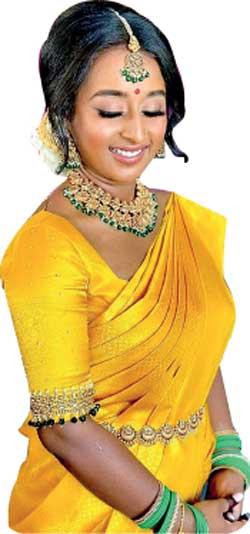 02. This practice is known as color astrology and though it may seem like superstition to outsiders it is a cherished belief for many. Wearing the right color is thought to balance spiritual energies and attract divine favor.
02. This practice is known as color astrology and though it may seem like superstition to outsiders it is a cherished belief for many. Wearing the right color is thought to balance spiritual energies and attract divine favor.
Interestingly some brides wear more than one saree during the course of the wedding. It is not uncommon for a Tamil bride to have different sarees for each part of the ceremony. One for the Kanyadanam when the bride is given away by her parents one for the Mangalya Dharanam when the sacred thread or thali is tied and another for the evening reception. Each saree is selected for its symbolic significance and its ability to reflect the bride’s transition from daughter to wife to hostess. The variety of colors used across these sarees also showcases the journey the bride is taking as she moves through each life stage.
03. There is also a belief that these traditional colors keep negative energies away. Red is said to ward off evil and protect the bride from any bad luck on her special day. Yellow with its association to the sun is thought to bring divine light to the ceremony. Green calls in nature’s blessings and represents harmony in the new household. In this sense color becomes a form of silent prayer stitched into the very fabric of the wedding celebration.
In modern times many Tamil brides have started experimenting with pastel tones or even shades like peach and lavender. Fashion designers have added modern cuts and contemporary styles to the traditional saree. However, when it comes to the main wedding ceremony most still stick to the traditional color palette. The connection to culture to the goddess to tradition and to the blessings of ancestors is something that continues to live through these saree choices no matter how the styles evolve.
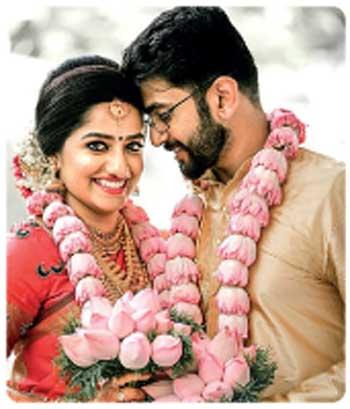 It is not just about the bride either. In Tamil weddings even the mothers of the bride and groom often coordinate their sarees in complementary colors to indicate their roles and to harmonize with the energy of the occasion. Female relatives and bridesmaids too sometimes wear matching colors as a mark of support and unity. The saree becomes a silent language spoken by all the women in the family a collective symbol of strength femininity and celebration.
It is not just about the bride either. In Tamil weddings even the mothers of the bride and groom often coordinate their sarees in complementary colors to indicate their roles and to harmonize with the energy of the occasion. Female relatives and bridesmaids too sometimes wear matching colors as a mark of support and unity. The saree becomes a silent language spoken by all the women in the family a collective symbol of strength femininity and celebration.
Ultimately the color of a Tamil bride’s saree is not simply a fashion statement it is a meaningful choice that ties her to her cultural roots and spiritual beliefs. Every thread is woven with emotion tradition and purpose. It marks the beginning of a new chapter not just with beauty but with blessings. When she walks into the wedding mandapam dressed in red, yellow, green or a blend of all three she carries the hopes of generations and the power of symbolism in every fold of her saree.
